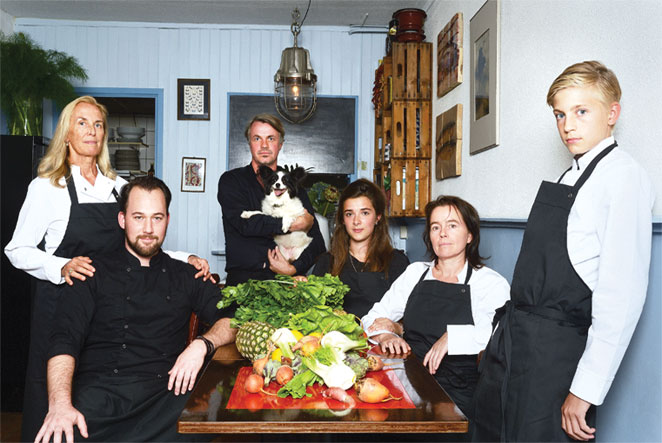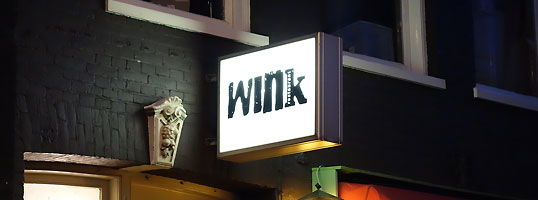Wink
When people think of Amsterdam, lots of things come to mind. For the hedonistically inclined, it’s the red light district and the “coffeeshops.”[1] For the artistically inclined, it’s the Rijks and Van Gogh museums. For the horticulturally inclined, it’s the tulip gardens. Would you think of delectable cuisine crafted from seasonal ingredients served up with panache? No? Neither did I, until I stumbled upon a restaurant called “Wink” serendipitously after taking an afternoon stroll through the Albert Cuyp market, which is conveniently located a stone’s throw away.[2]
I thought it was a private residence until I noticed a Zagat sign in the window. Instantly curious, I opened the door, tossed back a dark curtain, and was suddenly standing in a small dining room with maybe 10 unadorned wooden tables. A petite but sturdy woman wearing a head scarf emerged quietly from the kitchen and introduced herself as Natasja Postma, chef and co-owner. She shook my hand warmly and succinctly answered my question about her restaurant’s theme, which was “Mediterranean, but not what you would expect.” Her menu varied nightly depending upon what’s in season and she pointed to the chalkboard next to me. As if on cue, a tall, thin man carrying a box stuffed full of ingredients for tonight’s dinner swooshed through the curtain like a jet plane heading straight for the kitchen. “You can’t get any fresher than that!” I thought.
Fortunately, because it was a weekday and I was a party of one, Natasja offered to reserve me a table for dinner that night, which I gratefully accepted.[3] Fortune smiled upon me again when I returned to Wink later that evening and was seated right in front of the window by none other than the speedy delivery man, who turned out to be Wink’s other co-owner and Natasja’s husband, Jan Paul de Haas. The couple took a big risk by buying the building that houses Wink, which opened in the spring of 2013, but their investment appears to be paying off now that the restaurant has earned a reputation as a neighborhood sweet spot. In my humble opinion, the key to Wink’s success is the hard work and genuine authenticity of these two individuals who work together like Yin and Yang.
Let’s start with the Yang. A former advertising executive who had “given it all up to do what he truly loved to do,” Jan Paul played the multiple roles of maître d, server, and sommelier with infectious enthusiasm. Laughter, not loud music, filled the air, as Jan Paul flitted from table to table, charming every diner (myself included) with his vibrant sense of humor, joie de vivre, and consummate knowledge of the food and beverages on the menu.
Now, let’s talk about the Yin. Natasja Postma is an artist of the highest caliber. Her dishes —not unlike Rembrandt’s paintings of everyday people in his neighborhood—feature commonplace earthy elements, that when skillfully combined and served raw or cooked at the proper temperature for just the right amount of time, they produce an intriguing result that is nothing short of magical.
Despite the short list of menu items, I couldn’t decide what to order because Jan Paul’s tantalizing descriptions made me want everything. My indecision prompted Natasja to come to my table, but instead of treating me like her problem child, she seemed to enjoy the opportunity to communicate directly with a new guest. After asking me a few pointed questions about my dining preferences, Natasja walked back to the kitchen with confidence, as if she had read my thoughts through mental telepathy. Jan Paul explained that they were going to serve me a customized tasting menu. Impressive personalized service, right?!
My meal arrived one dish at a time, as follows: (1) amuse-bouche of Nicoise olives, crusty bread, and olive oil; (2) salad of shredded cabbage, watercress, chives, toasted mustard seeds, and crispy little balls made from ground chestnuts, dressed with olive oil and citrus; (3) puttanesca of fresh heirloom and cherry tomatoes, basil oil, fresh basil, calamari tentacles, deep fried anchovies, and what I suspected to be lemon. There may have even been some capers in there; (4) hummus made of butternut squash, tahini, falafel (tiny balls again), red and yellow beets, cilantro, mint, flash-fried bulgur wheat and pomegranate seeds; (5) sliced pork belly, sweet potato puree and savoy cabbage, sprinkled with fried pork skins; and (6) panna cotta topped with a vivid red wild berry coulis.
The first thing that struck me about Natasja’s cuisine was its uniqueness. Although she appears to borrow bits and pieces from French, Italian, Lebanese, and Californian culinary traditions, her finished product is entirely original. But it’s not just Natasja’s inventiveness that makes her dishes succeed; it’s the meticulous execution of her vision that elevates her creations from the level of “interesting” to “outstanding.”
My check arrived with a farewell token of appreciation that I’ll never forget. Bite-sized chocolate squares, denser than cake with a finer texture than brownies but with the same non-crumbly properties. Rich in complexity but not overly sweet, they are pure perfection on a plate. Manically, I said to Jan Paul: “I don’t know what you call these things, but whatever they are, I’m in love! Can I marry them?” With a twinkle in his eye, he replied: “In Holland, you can.”
[1] In case you haven’t heard, the term “coffeeshop” in Amsterdam is used to describe a store where people gather to buy and/or smoke marijuana. For more information from a trusted source, see https://www.ricksteves.com/watch-read-listen/read/articles/amsterdams-coffeeshops
[2] If you haven’t been to “The Cuyp,” you’re missing out! All the locals from hotel staff to housewives shop at this oversized outdoor market in the hipster haven known as the “De Pijp” District. See https://www.amsterdamlogue.com/albert-cuyp-market-where-amsterdam-locals-shop.html
[3] Here’s how the reservation worked. The table was mine all night, meaning I could show up any time after the kitchen opened and stay as long as I wanted. Really.


